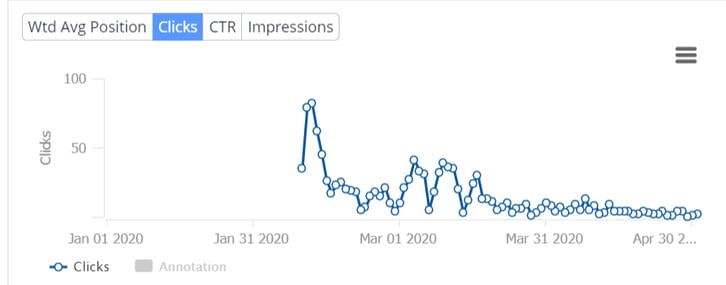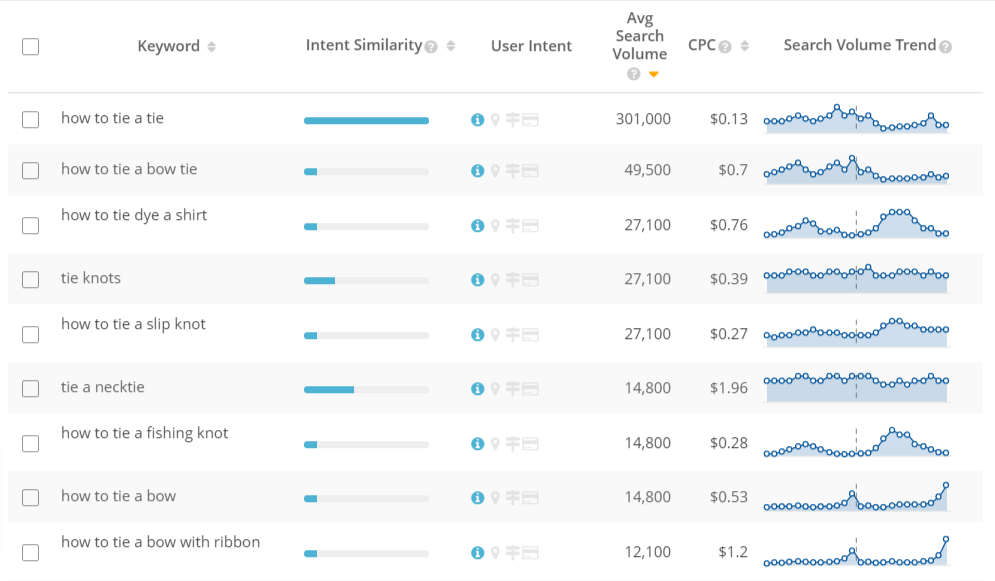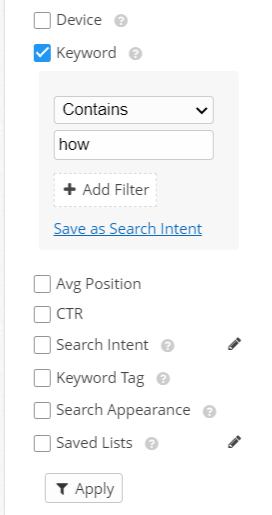What is Evergreen Content?
Evergreen content is content that continues to be relevant long after its initial publication. This means that the information it provides does not lose accuracy over time due to outside factors like seasonality or the news cycle.
Just like an evergreen tree always has its pines no matter the condition of the world around it, evergreen content is able to remain visible no matter the time of year because the topic it covers isn’t subject to major changes, making the content a near-permanent resource.
Imagine content that covers how to tie a tie, or how to fry an egg. Those processes won’t change for the foreseeable future, which makes the content always relevant — no matter when you publish.
Because of its longevity, it becomes more than a piece of content — it becomes an investment that constantly generates traffic to your site.
Creating content around the right topic of choice and pairing it with SEO content best practices allows you to use the “set it and forget it” strategy.
Types of Content for Evergreen Posts
Some content types are better suited for covering evergreen posts because of their presentation of the information.
Because the information tends to be explanatory and nearly unchangeable, the below list of content types tends to make for good evergreen content:
- Listicles
- How-to’s
- Reviews
- Beginner Guides
- Historic Explanations
- Checklists
- Definitions
- Recipes
- Glossaries
To get a further sense of what content is or is not evergreen, let’s take a look at some specific examples.
Examples of Evergreen Content
An age-old dilemma that many people face, and that many people search for! The process of tying a tie isn’t going to change, and that means your content won’t have to either. Hello, traffic for a lifetime!Even though technology develops at a rapid pace, consumer goods tend to stick around for a few years at minimum before they get an overhaul. This makes product reviews great candidates for evergreen content.
History is permanent. No one can go back in time to change what happened. This makes it great evergreen content. You can update it from time to time if a major development happens, but for the most part it does its job (i.e pulls in traffic with minimal effort). The piece above is from 2004 and still ranks on page one of the Google search results page!
I of course had to mention an SEO example here. Although SEO is a fast-moving industry, the basic principles that apply to search engine optimization tend to stay the same over periods of time. This is a reference that our content team put together for those just learning about SEO, and is relevant now, and will be in the future, too.
Examples of Non-Evergreen Content
As you know, the news world moves fast. This story may have pulled in traffic for a few days, but other newsworthy stories develop that push away its relevance.The title gives this one away: This content may have been popular in 2011, but new fads and trends come in to replace the existing styles.
The holiday season only rolls around once a year, so although this blog may pick up traction once a year, it still suffers from seasonality. With evergreen content, you want your content pulling in traffic all year long.
Another great piece of content from our marketing team, but not a great example of evergreen content. This blog post pulled in a surge of traffic when it was published, but since Google is constantly releasing new algorithm updates, this article became lost in a news cycle, and traffic began to dwindle.

(This content saw a surge of clicks upon publication, but the interest went away with time.)
Why is Evergreen Content Important?
Now that you know what evergreen content is, you probably have an idea of why it’s so crucial to a content strategy: evergreen content allows you to minimize your workload by creating content that is always going to perform.
You can of course (and should) create content that isn’t evergreen — we do, after all, cover major Google algorithm updates — but having evergreen content is a great defensive strategy to always ensure traffic.
Evergreen content has more benefits besides the traffic, too. It’s cheap, long-lasting, and what you get back is ten fold.
Plus, these content types can really lend themselves to Answer Box opportunities, which guarantees search visibility for your content at the top of the SERPs, and an evergreen piece of content is great for generating backlinks since it’s used as a helpful resource.
How Do You Make Evergreen Content?
There are two main steps to creating evergreen content: finding an appropriate evergreen topic, and then creating the content itself. Let’s discuss each in turn.
How to Find Evergreen Topics
A large part of creating evergreen content is understanding your vertical and your audience so you can be aware of different topics and perspectives to cover.
Also remember to check competitor websites with the skyscraping. That is, make a query for your target keyword to see how others cover the topic, and then cover the topic even better.
What questions are they answering?
But just like other content creation, you need to conduct keyword research to understand what users search for, and how they search for it, in a data-driven way.
Discovering Evergreen Topics
Evergreen content is all about writing about an evergreen topic.
Begin your keyword research journey by looking at broad topics to cover, and narrow in your scope from there.
Remember: when it comes to evergreen content, the first goal is to answer a question. (One that has an answer that will stay consistent!)
This should be the most top of mind element when creating the content.
Let’s take a look at an example of this using seoClarity’s Topic Explorer.
If you work in the apparel industry (i.e. manage a fashion blog or clothing store), users may be interested in different ways to wear items of clothing.
With Topic Explorer, you use a seed keyword to uncover related keywords and topics. Plus, you can specify your industry to focus on topics that are relevant to you.
Here, I’ve entered “tie a tie” as the main keyword. Then, I can see a list of related topics.

(Keyword list in Topic Explorer.)
Scrolling through the list I can see a variety of content ideas from the word cloud:
- How to tie a bow tie
- Tie a necktie
- How to tie a bow
- How to tie a bow with ribbon
Topic Explorer also reveals 24 months worth of search volume data for the terms. This can help inform your content strategy to capture demand at the right time.
Finding Questions to Answer
You can also dive into your site analytics to find the keywords that drive traffic to your site. This allows you to see the questions that users search for. Then, you can create content to answer those questions and drive traffic to your site.
To find this performance data, use Google Search Console.
The seoClarity platform integrates with GSC to pull in these data points, so I’ll demonstrate this approach with Search Analytics within the platform.
Filter with a qualifier like “who,” “what,” “why,” or “how” to find keywords that ask direct questions.

(Filtering GSC in seoClarity's Search Analytics.)
Collect these questions that your users are searching for. Evergreen content is created by finding out a way to timelessly answer those questions.
Looking at a demo account of H&M, this approach generated the following questions:
- How to track H&M orders
- How to use H&M gift card online
- How to cancel an order on H&M
- And plenty more!
These are the questions that users are asking, so they should be answered on your site. Since the process of tracking, canceling, etc. should most likely be consistent answers, these topics would make for great evergreen content.
You’ll have to use your industry knowledge to gauge whether the keywords you come across are good starting points for evergreen content, but one thing is for sure: these queries are all great targets for the Answer Box.
Familiarize yourself with your vertical and find as many perspectives as you can to present the information through. This can be done with experience, but also the data!
Check In on the Competition
Remember the skyscraping method: check in on the competition to see what they're covering in terms of their evergreen content strategy.
When you do browse other content, be sure to look at the actual spirit of the content. What does it cover? Looking at something like the publish date to gauge topic ideas is too much of a case by case basis.
Just because something was published long ago and still ranks doesn’t make it evergreen.
Writing Evergreen Content
The content creation process itself is just like creating any other piece of content; the challenge lies in finding the right topic to cover.
The good news is that now you know how to do that!
After you find your question, approve it for longevity, and pick the packaging for it (i.e. listicle, etc.) then you tackle the SEO presentation of it.
For example, you still want to make your content authoritative, and that’s something that Content Fusion, our AI content writer, can help you with.
We have a lot of other resources published too that can help make your content engaging for your users.
Content Resources:
- 8 Tricks to Creating Engaging Content
- 19 SEO Content Writing Tips: Create Copy That Both Google and Users Love
Conclusion
Evergreen content is a low risk, high reward approach to content creation. Since it targets an interest area/topic that will have demand for the foreseeable future, it can be a surefire way to guarantee traffic.
Updates to the content can still be made over time, but the heart of the piece stays the same.
If you’re looking to get started with evergreen content to boost your content marketing strategy, request a demo of our platform to learn how it can better inform your strategy.




-sep-29-2020-01-38-41-06-pm.jpg)

Comments
Currently, there are no comments. Be the first to post one!